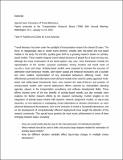| dc.contributor.author | Rashidi, Taha H. | |
| dc.contributor.author | Lima De Azevedo, Carlos Miguel | |
| dc.date.accessioned | 2016-12-08T19:44:15Z | |
| dc.date.available | 2017-09-03T05:00:05Z | |
| dc.date.issued | 2016-11 | |
| dc.identifier.issn | 0049-4488 | |
| dc.identifier.issn | 1572-9435 | |
| dc.identifier.uri | http://hdl.handle.net/1721.1/105754 | |
| dc.description.abstract | Travel behaviour has been under the spotlight of transportation research for almost 50 years. The focus on disaggregate data to model travel demand, initially with trip-based and tour-based models in the early 70s and 80s, quickly gave birth to a growing research stream on activity-based models. These models integrate travel related decisions of people for at least 1 day and, although the exact construction of the travel pattern may vary, most frameworks include the representation of the number, purposes (activities), timing, location and travel mode of traveller’s tours and stops. Activity-based models were proposed to increase the accuracy of alternative travel behaviour models, with higher spatial and temporal resolutions and a sounder and more realistic representation of key individual behaviours affecting travel. Their effectiveness prevails the alternative travel demand models when used for policy appraisal. Rule-based and utility-based frameworks have now reached the state-of-the-art and practice of activity-based models with several deployment efforts reported by metropolitan planning agencies, players in the transportation consultancy and software development fields. These efforts showed some of the key benefits of activity-based models, but also revealed more evidence for further research efforts by the research community. Further insights on the integration of activity-based models with dynamic network assignment models, on day-to-day dynamics, on non-observed or overlapping choice alternatives or decision dimensions, on more advanced behavioural formulations, such as the inclusion of social or household interactions, and on the development of computationally efficient deployments have caught the attention of the research community. This special issue presents the most recent achievements in some of these emerging research topics, including: | en_US |
| dc.publisher | Springer US | en_US |
| dc.relation.isversionof | http://dx.doi.org/10.1007/s11116-016-9743-1 | en_US |
| dc.rights | Article is made available in accordance with the publisher's policy and may be subject to US copyright law. Please refer to the publisher's site for terms of use. | en_US |
| dc.source | Springer US | en_US |
| dc.title | Papers presented at the Transportation Research Board (TRB) 94th Annual Meeting, Washington, D.C., January 11–15, 2015 | en_US |
| dc.type | Article | en_US |
| dc.identifier.citation | Rashidi, Taha H., and Carlos M. Lima Azevedo. “Papers Presented at the Transportation Research Board (TRB) 94th Annual Meeting, Washington, D.C., January 11–15, 2015.” Transportation 43, no. 6 (November 2016): 951–953. | en_US |
| dc.contributor.department | Massachusetts Institute of Technology. Department of Civil and Environmental Engineering | en_US |
| dc.contributor.mitauthor | Lima De Azevedo, Carlos Miguel | |
| dc.relation.journal | Transportation | en_US |
| dc.eprint.version | Author's final manuscript | en_US |
| dc.type.uri | http://purl.org/eprint/type/JournalArticle | en_US |
| eprint.status | http://purl.org/eprint/status/PeerReviewed | en_US |
| dc.date.updated | 2016-11-11T04:35:54Z | |
| dc.language.rfc3066 | en | |
| dc.rights.holder | Springer Science+Business Media New York | |
| dspace.orderedauthors | Rashidi, Taha H.; Azevedo, Carlos M. Lima | en_US |
| dspace.embargo.terms | N | en |
| mit.license | PUBLISHER_POLICY | en_US |
| mit.metadata.status | Complete | |
